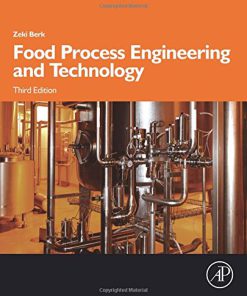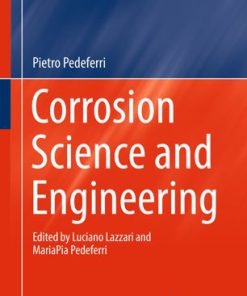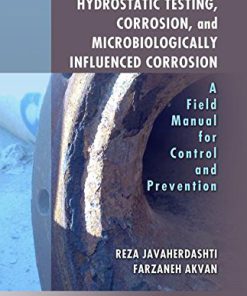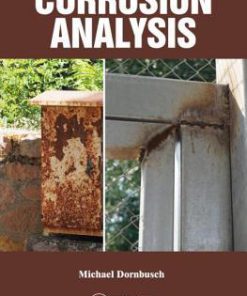Corrosion Science and Technology 3rd Edition by David Talbot, James Talbot 1351259903 9781351259903
$50.00 Original price was: $50.00.$25.00Current price is: $25.00.
Corrosion Science and Technology 3rd Edition by David E.J. Talbot, James D.R Talbot – Ebook PDF Instant Download/DeliveryISBN: 1351259903, 9781351259903
Full download Corrosion Science and Technology 3rd Edition after payment.
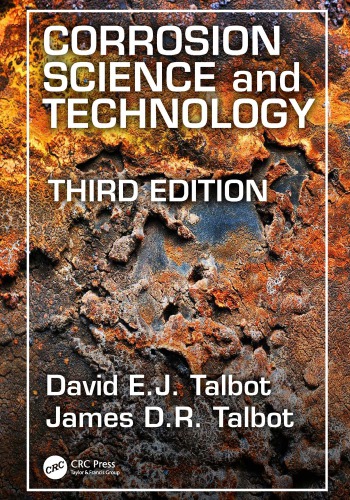
Product details:
ISBN-10 : 1351259903
ISBN-13 : 9781351259903
Author: David E.J. Talbot, James D.R Talbot
Twenty years after its first publication, Corrosion Science and Technology continues to be a relevant practical guide for students and professionals interested in material science. This Third Edition thoroughly covers the basic principles of corrosion science in the same reader-friendly manner that made the previous editioninvaluable, and enlarges the scope of the content with expanded chapters on processes for various metals and new technologies for limiting costs and metal degradation in a variety of commercial enterprises not explored in previous editions. This book also presents expertly developed methods of corrosion testing and prediction.
Corrosion Science and Technology 3rd Table of contents:
1. Overview of Corrosion and Protection Strategies
1.1 Corrosion in Aqueous Media
1.1.1 Corrosion as a System Characteristic
1.1.2 The Electrochemical Origin of Corrosion
1.1.3 Stimulated Local Corrosion
1.2 Thermal Oxidation
1.2.1 Protective Oxides
1.2.2 Nonprotective Oxides
1.3 Environmentally Sensitive Cracking
1.4 Strategies for Corrosion Control
1.4.1 Passivity
1.4.2 Conditions in the Environment
1.4.3 Cathodic Protection
1.4.4 Protective Coatings
1.4.5 Corrosion Costs
1.4.6 Criteria for Corrosion Failure
1.4.7 Material Selection
1.4.8 Geometric Factors
1.5 Some Symbols, Conventions and Equations
1.5.1 Ions and Ionic Equations
1.5.2 Partial Reactions
1.5.3 Representation of Corrosion Processes
1.5.3.1 Active Dissolution of Iron with Oxygen Absorption
1.5.3.2 Passivity of Iron in Alkaline Water
Further Reading
2. Structures Participating in Corrosion Processes
2.1 Origins and Characteristics of Structure
2.1.1 Phases
2.1.1.1 Crystalline Solids
2.1.1.2 Liquids
2.1.1.3 Non-Crystalline Solids
2.1.1.4 Gases
2.1.2 The Role of Electrons in Bonding
2.1.2.1 Atomic Orbitals
2.1.2.2 Molecular Orbitals and Bonding of Atoms
2.1.3 The Concept of Activity
2.2 The Structure of Water and Aqueous Solutions
2.2.1 The Nature of Water
2.2.2 The Water Molecule
2.2.3 Liquid Water
2.2.3.1 Hydrogen Bonding
2.2.3.2 Dielectric Constant
2.2.3.3 Viscosity
2.2.4 Autodissociation and pH of Aqueous Solutions
2.2.5 The pH Scale
2.2.6 Foreign Ions in Solution
2.2.7 Ion Mobility
2.2.8 Structures of Water and Ionic Solutions at Metal Surfaces
2.2.9 Constitutions of Hard and Soft Natural Waters
2.2.9.1 Rainwater
2.2.9.2 Hard Waters
2.3 The Structures of Metal Oxides
2.3.1 Electronegativity
2.3.2 Partial Ionic Character of Metal Oxides
2.3.3 Oxide Crystal Structures
2.3.3.1 Simple Cubic Structures (Rock Salt, NaCl Structure)
2.3.3.2 Rhombohedral–Hexagonal Structures (Corundum Structure)
2.3.3.3 Rutile Structures
2.3.3.4 Spinel Structures
2.3.3.5 Brucite Structures
2.3.3.6 Other Structures
2.3.4 Conduction and Valence Electron Energy Bands
2.3.5 The Origins of Lattice Defects in Metal Oxides
2.3.5.1 General Approach
2.3.5.2 Configurational Entropy of Atoms or Ions on a Lattice
2.3.5.3 Equilibrium Number of Defects
2.3.5.4 Nature of Defects in Oxide Lattices
2.3.5.5 Representation of Defects
2.3.6 Classification of Oxides by Defect Type
2.3.6.1 Stoichiometric Oxides
2.3.6.2 Cation Excess Oxides
2.3.6.3 Cation Deficit Oxides
2.3.6.4 Anion Deficit Oxides
2.3.6.5 Intrinsic Semiconductors
2.3.6.6 Degrees of Non-Stoichiometry
2.4 The Structures of Metals
2.4.1 The Metallic Bond
2.4.2 Crystal Structures and Lattice Defects
2.4.3 Phase Equilibria
2.4.3.1 Solid Solutions
2.4.3.2 Eutectic Transformations
2.4.3.3 Peritectic Transformations
2.4.3.4 Eutectoid Transformations
2.4.3.5 Intermetallic Compound Formation
2.4.3.6 Real Systems
2.4.4 Structural Artefacts Introduced during Manufacture
2.4.4.1 Structural Features of Castings and Ingots
2.4.4.2 Characteristics Imparted by Mechanical Working
Further Reading
3. Thermodynamics and Kinetics of Corrosion Processes
3.1 Thermodynamics of Aqueous Corrosion
3.1.1 Oxidation and Reduction Processes in Aqueous Solution
3.1.1.1 Oxidation States
3.1.1.2 Electrodes
3.1.2 Equilibria at Electrodes and the Nernst Equation
3.1.3 Standard State for Activities of Ions in Solution
3.1.4 Electrode Potentials
3.1.4.1 Convention for Representing Electrodes at Equilibrium
3.1.4.2 Choice of a Potential Scale
3.1.4.3 The Standard Hydrogen Electrode
3.1.5 Pourbaix (Potential-pH) Diagrams
3.1.5.1 Principle and Purpose
3.1.5.2 Example of the Construction of a Diagram – The Iron–Water System
3.1.5.3 The Domain of Stability for Water
3.1.5.4 Application of Pourbaix Diagrams to Corrosion Problems
3.1.5.5 Pourbaix Diagrams for Some Metals of Interest in Corrosion
3.1.5.6 Limitations of Pourbaix Diagrams
3.2 Kinetics of Aqueous Corrosion
3.2.1 Kinetic View of Equilibrium at an Electrode
3.2.2 Polarization
3.2.2.1 Activation Polarization
3.2.2.2 Concentration Polarization
3.2.2.3 Resistance Polarization
3.2.2.4 The Hydrogen Evolution Reaction and Hydrogen Overpotential
3.2.2.5 The Oxygen Reduction Reaction
3.2.3 Polarization Characteristics and Corrosion Velocities
3.2.3.1 Corrosion Velocity Diagrams
3.2.3.2 Differential Polarization for Oxygen Reduction and Crevice Corrosion
3.2.4 Passivity
3.2.4.1 Spontaneous Passivation
3.2.4.2 Anodic Passivation
3.2.4.3 Theories of Passivation
3.2.5 Breakdown of Passivity
3.2.5.1 General Breakdown of Passivity
3.2.5.2 Local Breakdown of Passivity
3.2.5.3 Mechanical Breakdown of Passivity
3.2.6 Corrosion Inhibitors
3.2.6.1 Cathodic Inhibitors
3.2.6.2 Anodic Inhibitors
3.3 Thermodynamics and Kinetics of Dry Oxidation
3.3.1 Factors Promoting the Formation of Protective Oxides
3.3.2 Thin Films and the Cabrera–Mott Theory
3.3.3 Thick Films, Thermal Activation and the Wagner Theory
3.3.3.1 Oxidation of Metals Forming Cation Interstitial (n-type) Oxides
3.3.3.2 Oxidation of Metals Forming Cation Vacancy (p-type) Oxides
3.3.3.3 Oxidation of Metals Forming Anion Vacancy (n-type) Oxides
3.3.3.4 Oxidation of Metals Forming Stoichiometric Ionic Oxides
3.3.3.5 Time and Temperature Dependence of Diffusion-Controlled Oxidation
3.3.3.6 Correlations with Other Observations
3.3.3.7 Effects of Impurities
3.3.3.8 Loss of Integrity of Protective Oxides
3.3.4 Selective Oxidation of Components in an Alloy
3.3.4.1 Principles
3.3.4.2 Oxidation of Alloys Forming Complex Oxides
3.3.4.3 Kinetic Considerations
Problems
Appendix: Construction of Some Pourbaix Diagrams
Further Reading
4. Mixed Metal Systems
4.1 Galvanic Stimulation
4.1.1 Bimetallic Couples
4.1.2 The Origin of the Bimetallic Effect
4.1.3 Design Implications
4.1.3.1 Active and Weakly Passive Metals
4.1.3.2 Active/Passive Couples
4.1.3.3 Cathodic Collectors
4.1.3.4 Compatibility Groups
4.1.3.5 Indirect Stimulation
4.1.3.6 Variable Polarity
4.2 Galvanic Protection
4.2.1 Principle
4.2.2 Galvanic Protection by Coatings
4.2.2.1 Zinc Coatings on Steel
5. The Intervention of Stress
5.1 Stress-Corrosion Cracking
5.1.1 Characteristic Features
5.1.2 SCC in Aluminium Alloys
5.1.2.1 Susceptible Alloys
5.1.2.2 Probable Causes
5.1.2.3 Mechanisms
5.1.3 SCC in Stainless Steels
5.1.3.1 Brief Description of the Phenomena
5.1.3.2 Environmental Influences
5.1.3.3 Sensitivity to Steel Structure and Composition
5.1.3.4 Mechanisms
5.1.4 Stress Corrosion Cracking in Plain Carbon Steels
5.1.4.1 Brief General Description of the Phenomena
5.1.4.2 Mechanisms
5.2 Corrosion Fatigue
5.2.1 Characteristic Features
5.2.2 Mechanisms
5.2.2.1 Mechanical Events Causing Failure
5.2.2.2 Intervention of the Environment
5.3 Enhanced Corrosion in Flowing or Turbulent Aqueous Media
5.3.1 Erosion–Corrosion
5.3.2 Cavitation
5.4 Precautions against Stress-Induced Failures
5.4.1 Materials
5.4.2 Environments
5.4.3 Stresses
5.4.4 Geometry
5.4.5 Monitoring
Further Reading
6. Protective Coatings
6.1 Surface Preparation
6.1.1 Surface Conditions of Manufactured Metal Forms
6.1.1.1 Rolled Surfaces
6.1.1.2 Extruded Surfaces
6.1.1.3 Surfaces of Press-Formed Products
6.1.2 The Cleaning and Preparation of Metal Surfaces
6.1.2.1 Descaling Steels
6.1.2.2 Cleaning Aluminium Surfaces
6.1.2.3 Preparation of Aluminium Substrates for Electrodeposits
6.1.2.4 Chemical and Electrochemical Polishing of Aluminium Alloys
6.2 Electrodeposition
6.2.1 Application and Principles
6.2.1.1 Cathodic and Anodic Reactions
6.2.1.2 Hydrogen Discharge
6.2.1.3 Throwing Power
6.2.1.4 Illustrative Selection of Deposition Processes
6.2.2 Electrodeposition of Nickel
6.2.2.1 General Considerations
6.2.2.2 Bright Nickel Plating
6.2.2.3 Other Nickel Plating Processes
6.2.2.4 Electroless Nickel/Phosphorus Plating
6.2.3 Electrodeposition of Copper
6.2.3.1 Acid Sulfate Baths
6.2.3.2 Alkaline Cyanide Baths
6.2.4 Electrodeposition of Chromium
6.2.4.1 Applications
6.2.4.2 Principles of Deposition
6.2.4.3 Operation of Chromic Acid Baths
6.2.4.4 Quality of the Deposit
6.2.5 Electrodeposition of Tin
6.2.5.1 General Principles
6.2.5.2 Acid Tin Baths
6.2.5.3 Alkaline Stannate Baths
6.2.5.4 Halide Baths
6.2.6 Electrodeposition of Zinc
6.2.6.1 Acid Sulfate Baths
6.2.6.2 Alkaline Cyanide Baths
6.3 Hot-Dip Coatings
6.3.1 Zinc Coatings (Galvanizing)
6.3.2 Tin Coatings
6.3.3 Aluminium Coatings
6.4 Conversion Coatings
6.4.1 Phosphating
6.4.1.1 Mechanism of Phosphating
6.4.1.2 Accelerated Phosphating Processes
6.4.2 Anodizing
6.4.2.1 Mechanism of Anodizing
6.4.2.2 Practice
6.4.2.3 Applications
6.4.3 Chromating
6.4.3.1 Coatings on Aluminium
6.4.3.2 Coatings on Zinc
6.4.3.3 Coatings on Magnesium Alloys
6.5 Paint Coatings for Metals
6.5.1 Paint Components
6.5.1.1 Binding Media
6.5.1.2 Pigments and Extenders
6.5.1.3 Solvents
6.5.2 Applications
6.5.2.1 Traditional Paints
6.5.2.2 Waterborne Paints
6.5.3 Paint Formulations
6.5.4 Protection of Metals by Paint Systems
Further Reading
7. Corrosion of Iron and Steels
7.1 Iron and Steel Microstructures
7.1.1 Solid Solutions in Iron
7.1.2 The Iron–Carbon System
7.1.3 Plain Carbon Steels
7.1.3.1 Normalized Steels
7.1.3.2 Quenched and Tempered Steels
7.1.4 Cast Irons
7.2 Rusting
7.2.1 Species in the Iron–Oxygen–Water System
7.2.1.1 Iron(III) Oxides, Hydrous Oxides and Derivatives
7.2.1.2 Iron(II) Oxides, Hydroxides and Derivatives
7.2.1.3 Protective Value of Solid Species
7.2.2 Rusting in Aerated Water
7.2.2.1 Fresh Waters
7.2.2.2 Sea Waters
7.2.2.3 Alkaline Waters
7.2.2.4 Suppression of Corrosion by Impressed Currents
7.2.3 Rusting in Air
7.2.3.1 Rusting Due to Atmospheric Humidity
7.2.3.2 Rusting from Intermittent Wetting
7.2.4 Rusting of Cast Irons
7.2.4.1 Gray Flake Irons
7.2.4.2 Other Irons
7.3 The Oxidation of Iron and Steels
7.3.1 Crystallographic and Defect Structures of Oxides
7.3.2 Phase Equilibria in the Iron–Oxygen System
7.3.3 Application of Wagner’s Oxidation Mechanisms
7.3.3.1 Nature of Scales
7.3.3.2 Diffusing Species and Growth Interfaces
7.3.3.3 Oxidation Rates
7.3.4 Oxidation of Steels
7.3.4.1 Effects of Alloying Elements and Impurities
7.3.4.2 Influence on Metal Quality of Scales Formed during Manufacture
7.3.4.3 Oxidation in Industrial Conditions
7.3.5 Oxidation and Growth of Cast Irons
7.3.5.1 Internal Oxidation
7.3.5.2 Graphitization
Further Reading
8. Stainless Steels
8.1 Phase Equilibria
8.1.1 The Iron–Chromium System
8.1.2 Effects of Other Elements on the Iron–Chromium System
8.1.2.1 Carbon
8.1.2.2 Nickel
8.1.2.3 Nickel and Carbon Present Together
8.1.2.4 Molybdenum
8.1.2.5 Other Elements
8.1.3 Schaeffler Diagrams
8.2 Commercial Stainless Steels
8.2.1 Classification
8.2.2 Structures
8.2.2.1 Ferritic Steels
8.2.2.2 Austenitic Steels
8.2.2.3 Martensitic Steels
8.2.2.4 Duplex Steels
8.2.2.5 Precipitation-Hardening Steels
8.3 Resistance to Aqueous Corrosion
8.3.1 Evaluation from Polarization Characteristics
8.3.1.1 Relevance to Corrosion Resistance
8.3.1.2 Determination
8.3.1.3 Presentation
8.3.1.4 Influence of the Environment
8.3.1.5 Influence of Steel Composition and Condition
8.3.2 A Chemical View of Passivity in Iron Chromium Alloys
8.3.2.1 Oxidation States of Chromium and Related Equilibria
8.3.2.2 Relation of Polarization Characteristics to Chromium Chemistry
8.3.3 Corrosion Characteristics of Stainless Steels
8.3.3.1 Corrosion Resistance in Acids
8.3.3.2 Pitting Corrosion
8.3.3.3 Crevice Corrosion
8.3.3.4 Sensitization and Intergranular Corrosion
8.3.3.5 Corrosion in Aggressive Chemical Environments
8.4 Resistance to Dry Oxidation
8.5 Applications
8.5.1 Ferritic Steels
8.5.2 Austenitic Steels
8.5.2.1 Austenitic Steels without Molybdenum
8.5.2.2 Austenitic Steels with Molybdenum
8.5.2.3 Austenitic Steels with Manganese Substitution
8.5.3 Hardenable Steels
8.5.4 Duplex Steels
8.5.5 Oxidation-Resistant Steels
8.6 Applications of Cast Stainless Steels
Problems
Further Reading
9. Corrosion Resistance of Aluminium and Aluminium Alloys
9.1 Physical Metallurgy of Some Standard Alloys
9.1.1 Alloys Used without Heat Treatment
9.1.1.1 Commercial Pure Aluminium Grades (AA 1XXX Alloy Series)
9.1.1.2 Aluminium–Manganese Alloy AA 3003
9.1.1.3 Aluminium–Magnesium Alloys (AA 5000 Series)
9.1.1.4 Aluminium–Magnesium–Manganese Alloy AA 3004
9.1.2 Heat-Treatable (Aging) Alloys
9.1.2.1 Aluminium–Copper–Magnesium Alloys (e.g., AA 2024)
9.1.2.2 Aluminium–Zinc–Magnesium Alloys (e.g., AA 7075)
9.1.2.3 Aluminium–Magnesium–Silicon Alloys (e.g., AA 6061)
9.1.2.4 Aluminium Alloys Containing Lithium
9.1.3 Casting Alloys
9.2 Corrosion Resistance
9.2.1 The Aluminium–Oxygen–Water System
9.2.1.1 Solid Species
9.2.1.2 Soluble Species
9.2.2 Corrosion Resistance of Pure Aluminium in Aqueous Media
9.2.2.1 Passivation
9.2.2.2 Corrosion Resistance in Natural Waters
9.2.2.3 Corrosion Resistance in Acidic and Alkaline Media
9.2.3 Corrosion Resistance of Aluminium Alloys in Aqueous Media
9.2.3.1 Chemical Composition of the Metal
9.2.3.2 Structure Sensitivity
9.2.3.3 Stress-Corrosion Cracking
9.2.3.4 Galvanically Stimulated Attacks
9.2.4 Corrosion Resistance of Aluminium and Its Alloys in Air
9.2.4.1 Nature of Air-Formed Film
9.2.4.2 Weathering
9.2.5 Geometric Effects
9.2.5.1 Crevices
9.2.5.2 Impingement, Cavitation and Erosion–Corrosion
9.2.6 Oxidation of Aluminium–Magnesium Alloys during Manufacture
9.2.6.1 Enhanced Oxidation by Sulfur Pollution
9.2.6.2 Oxide Precursor of Magnesium Carbonate Films
Further Reading
10. Corrosion Resistance of Copper and Copper Alloys
10.1 Chemical Properties and Corrosion Behaviour of Pure Copper
10.1.1 The Copper–Oxygen–Water System
10.1.2 Corrosion Resistance in Natural Environments
10.1.2.1 The Atmosphere
10.1.2.2 Natural Waters
10.1.2.3 Soils
10.1.3 Water Supply and Circulation Systems
10.1.3.1 Surface Films as Cathodic Collectors
10.1.3.2 Impingement Attack
10.1.3.3 Pitting
10.1.4 Stress-Related Corrosion Failure
10.1.5 Corrosion of Associated Metals by Galvanic Stimulation
10.2 Constitutions and Corrosion Behaviour of Copper Alloys
10.2.1 Alloys Based on the Copper–Zinc System—Brasses
10.2.1.1 Phase Equilibria for the Copper–Zinc Binary System
10.2.1.2 Formulation and Characteristics of Alloys
10.2.1.3 Corrosion Resistance
10.2.2 Alloys Based on the Copper–Aluminium System
10.2.2.1 Phase Equilibria for the Copper–Aluminium Binary System
10.2.2.2 Formulation and Characteristics of Alloys
10.2.2.3 Corrosion Resistance
10.2.3 Alloys Based on the Copper–Nickel System
10.2.3.1 Phase Equilibria for the Copper–Nickel Binary System
10.2.3.2 Formulation and Characteristics of Alloys
10.2.3.3 Corrosion Resistance in Water
10.2.4 Alloys Based on the Copper–Tin System
10.2.4.1 Phase Equilibria for the Copper–Tin Binary System
10.2.4.2 Formulation and Characteristics of Alloys
10.2.4.3 Corrosion Resistance
Further Reading
11. Corrosion Resistance of Nickel and Its Alloys
11.1 Chemical Properties and Corrosion Behaviour of Pure Nickel
11.1.1 The Nickel–Oxygen–Water System
11.1.2 Corrosion Resistance in Natural Environments
11.1.2.1 The Natural Atmosphere
11.1.2.2 Natural Waters
11.1.3 Corrosion Resistance in Neutral and Alkaline Media
11.1.4 Corrosion Resistance in Acidic Media
11.1.5 Non-Aqueous Media
11.2 Constitutions and Corrosion Behaviour of Nickel Alloys
11.2.1 Nickel Alloys for General Corrosion Resistance
11.2.1.1 Nickel–Copper Alloys (Monels)
11.2.1.2 Nickel–Chromium Alloys (Nichrome and Inconel)
11.2.1.3 Nickel Alloys Containing Molybdenum
11.2.2 Superalloys for Gas Turbine Components
11.2.2.1 Properties of Materials for Gas Turbines
11.2.2.2 Design of Microstructures
11.2.2.3 Alloy Range
12. Corrosion Resistance of Titanium and Its Alloys
12.1 Chemical Characteristics and Corrosion Behaviour of Pure Titanium
12.1.1 The Titanium–Water System
12.1.2 Corrosion Resistance
12.1.2.1 Passivity
12.1.2.2 Stress-Related Corrosion
12.1.2.3 Titanium in Mixed Metal Systems
12.1.2.4 Resistance to Natural Environments
12.1.2.5 Resistance to Acids
12.2 Constitutions and Corrosion Behaviour of Titanium Alloys
12.2.1 Alloy Formulation
12.2.2 Noble Metal Additions for Improved Resistance to Non-Oxidizing Acids
12.3 Applications
12.3.1 Aerospace Applications
12.3.2 Marine Applications
12.3.3 Representative Industrial Applications
12.3.3.1 Chemical and Related Process Plants
12.3.3.2 Bleaching and Bleaching Agents
12.3.3.3 Oilfield Equipment
12.3.3.4 Anodes for Cathodic Protection
12.3.3.5 Equipment for Metal Surface Treatments
12.3.4 Medical Applications
12.3.4.1 Titanium Alloy Joint Replacements
12.3.4.2 Other Titanium Implants and Prostheses
13. Corrosion Resistance of Zinc
13.1 Occurrence and Extraction
13.1.1 Sources
13.1.2 Blast Furnace Reduction
13.1.3 Electrolytic Extraction
13.2 Structure and Properties
13.2.1 Structure and Physical Properties
13.2.2 Chemical Properties
13.2.2.1 Electron Configuration
13.2.2.2 Passivation
13.3 Applications
13.3.1 Surface Coatings on Steel
13.3.2 Sacrificial Anodes
13.3.3 Batteries Based on the Leclanché Cell
13.3.4 Diecastings
13.4 Corrosion Characteristics of Zinc
13.4.1 Corrosion in Aqueous Solution
13.4.2 Corrosion in Normal Atmospheres
13.5 Cadmium
Further Reading
14. Corrosion Resistance of Magnesium and Its Alloys
14.1 Physical Properties
14.1.1 Occurrence and Extraction
14.2 Chemical Properties
14.3 Corrosion Resistance
14.3.1 Corrosion Resistance in Aqueous Solution
14.3.2 Corrosion Resistance in Dry Oxidation
14.4 Alloy Formulation
14.5 Canning for Nuclear Reactor Fuel
14.6 Stress-Corrosion Cracking
14.6.1 Susceptible Alloys
14.6.2 Mechanisms
14.7 Magnesium Sacrificial Anodes
14.8 Protection of Magnesium by Coatings
14.8.1 Paint Systems
14.8.2 Anodizing
15. Corrosion Resistance of Tin and Tin Alloys
15.1 Occurrence Extraction and Refining
15.2 Chemical Characteristics and Corrosion Resistance
15.2.1 Corrosion Resistance in Natural Environments
15.2.2 Applications
15.2.2.1 Tin Coatings on Steel for Food Cans
15.2.2.2 Soft Solders
15.2.2.3 Lead-Free Solders
15.2.3 Bearings
15.2.4 Pure Tin and Pewter
16. Corrosion Resistance of Lead
16.1 Occurrence and Extraction
16.2 Chemical Characteristics and Corrosion Behaviour
16.2.1 Chemical Characteristics
16.2.2 Corrosion Resistance
16.2.2.1 Corrosion Resistance in Air and Water
16.2.2.2 Corrosion Resistance in Acids
16.2.2.3 Effects of Stress
16.3 Applications
16.3.1 Lead Acid Batteries
16.3.2 Equipment for Electrochemical Metal Finishing
16.3.2.1 Electrodeposition of Metals
16.3.2.2 Anodizing Aluminium
16.3.3 Roofing Materials
17. Corrosion Resistance of Zirconium and Hafnium
17.1 Occurrence Extraction and Refining
17.2 Some Chemical Characteristics and Corrosion Behaviour
17.2.1 Corrosion Resistance
17.2.1.1 Oxidation Mechanisms
17.2.1.2 Passivity
17.2.1.3 Breakdown of Passivity
17.3 Applications
17.3.1 Nuclear Applications
17.3.2 Chemical, Industrial and Medical Applications
18. Corrosion Resistance of Beryllium
18.1 Occurrence and Extraction
18.1.1 Sources
18.1.2 Extraction of Raw Metal by Halide Routes
18.1.3 Purification Swarfing and Consolidation
18.2 Characteristics of Commercially Pure Metal
18.2.1 Structure and Physical Properties
18.2.2 Nuclear Properties
18.2.3 Chemical Properties and Corrosion Behaviour
18.2.3.1 Electron Configuration
18.2.3.2 Chemical Characteristics
18.2.3.3 Passivation by Surface Oxide Film
18.2.3.4 Pitting at Local Cathodic Collectors
18.2.3.5 Effects of Carbide Inclusions
18.3 Applications
18.3.1 Nuclear Reactors
18.3.1.1 Responses to Reactor Environments
18.3.1.2 Integrity of Beryllium as a Structural Material
18.3.2 Applications Exploiting High Strength to Weight Ratio
19. Corrosion Resistance of Uranium
19.1 Occurrence and Extraction of the Natural Metal
19.2 Uranium Metallurgy and Chemistry
19.2.1 Metallurgy
19.2.2 Chemical Characteristics
19.3 Corrosion in Water and Steam
19.3.1 Corrosion Products
19.3.2 Kinetics
19.3.3 Effects of Hydrogen Absorption
19.4 Oxidation
19.4.1 Uranium–Oxygen Phase Equilibria
19.4.2 Critical Review of Uranium Oxide Structures
19.4.3 Application of Critical Review to Oxidation Kinetics
19.4.4 Effects of Alloying Elements on Oxidation Kinetics
20. Cathodic Protection
20.1 Principles
20.2 Buried Pipelines and Distribution Systems
20.2.1 Protection by Impressed Current
20.2.1.1 Schemes for New Buried Pipelines
20.2.1.2 Retrofitting to Existing Buried Pipelines
20.2.1.3 Anodes and Groundbeds for Impressed Current
20.2.2 Protection by Sacrificial Anodes
20.3 Cathodic Protection in Open Waters
20.3.1 Protection of Ships’ Hulls
20.3.1.1 Protection of Hulls by Impressed Current
20.3.1.2 Protection of Hulls by Sacrificial Anodes
20.3.1.3 Protection of Internal Hull Components
20.3.2 Protection of Coastal and Offshore Installations
20.4 Side Reactions and Overprotection
20.5 Measuring Instruments
20.5.1 Measurement of Potentials
20.5.1.1 Buried Pipes and Utilities
20.5.1.2 Immersed Structures
20.5.2 Measurement of Soil Resistivities
Further Reading
21. Corrosion and Corrosion Control in Aviation
21.1 Airframes
21.1.1 Materials of Construction
21.1.2 Corrosion and Protection of Airframes
21.1.2.1 Aluminium Alloys
21.1.2.2 Titanium Alloys
21.1.2.3 Other Metals
21.1.3 Environmentally Sensitive Cracking
21.1.3.1 Fatigue
21.1.3.2 Stress-Corrosion Cracking
21.1.4 Systematic Assessment for Corrosion Control
21.2 Gas Turbine Engines
21.2.1 Engine Operation
21.2.2 Application and Performance of Nickel Alloys
21.2.2.1 Oxidation in Unpolluted Combustion Products
21.2.2.2 Aluminizing for Oxidation Resistance
21.2.2.3 Hot Corrosion and Sulfidation
21.2.3 Engine Environments
21.2.3.1 Factors Related to Engine Operation
21.2.3.2 Flight Pattern Factors
21.2.3.3 Fatigue
21.2.4 Alloy Selection
21.2.4.1 Turbine Blades
21.2.4.2 Turbine Discs
21.2.4.3 Combustion Chambers
21.2.4.4 Compressor Assemblies
21.2.4.5 Cool Components
Further Reading
22. Corrosion Control in Automobile Manufacture
22.1 Overview
22.2 Corrosion Protection for Automobile Bodies
22.2.1 Design Considerations
22.2.1.1 Front and Side Panels
22.2.1.2 Wheel Arches
22.2.1.3 Joints
22.2.1.4 Rainways
22.2.2 Overview of Paint Shop Operations
22.2.3 Cleaning and Pretreatment of Body Shells
22.2.4 Phosphating
22.2.5 Application of Paint
22.2.5.1 Primer Coat and Sealing
22.2.5.2 Undercoating Colour and Gloss Coats
22.2.5.3 Supplementary Protection
22.2.6 Whole Body Testing
22.3 Corrosion Protection for Engines
22.3.1 Exhaust Systems
22.3.2 Cooling Systems
22.3.3 Moving Parts
22.4 Bright Trim
22.4.1 Electrodeposited Nickel Chromium Systems
22.4.2 Anodized Aluminium
Further Reading
23. Corrosion Control in Food Processing and Distribution
23.1 General Considerations
23.1.1 Public Health
23.1.1.1 Control of Hygiene at Food/Metal Contacts
23.1.2 Food Product Environments
23.1.2.1 Bacteria in the Environment
23.1.2.2 Emulsified Environments
23.1.2.3 Interaction between Inorganic and Organic Solutes
23.1.2.4 Practical Aspects of Corrosion Control
23.2 Production of Tinplate for Food Cans
23.2.1 Historical
23.2.2 Modern Tinplate Cans
23.2.2.1 Electrodeposition, Flow Melting and Passivation
23.2.2.2 Three-Piece Cans
23.2.2.3 Draw/Redraw Cans
23.2.2.4 Draw/Wall-Iron Cans
23.2.3 Tin-Free Steel for Food Packaging
23.3 Dairy Industries
23.3.1 Milk and Its Derivatives
23.3.1.1 Constitution
23.3.1.2 Processing
23.3.2 Materials Used in the Dairy Industry
23.3.2.1 Surfaces in Contact with the Product
23.3.2.2 Surfaces Not in Contact with the Product
23.4 Brewing
23.4.1 The Brewing Process
23.4.2 Materials Used for Brewing Plants
23.4.2.1 General Corrosion Resistance
23.4.2.2 Stress-Corrosion Cracking
23.4.2.3 Biologically Promoted Corrosion in Spent Grain Hoppers
23.4.2.4 Cleaning and Sterilization
23.4.3 Beer Barrels, Casks and Kegs
23.4.3.1 Historical
23.4.3.2 Design
23.4.3.3 Materials
Further Reading
24. Control of Corrosion in Building Construction
24.1 Introduction
24.2 Structures
24.2.1 Steel Bar for Reinforced Concrete Frames
24.2.1.1 Reinforced Concrete
24.2.1.2 Chemical Environment in Concrete
24.2.1.3 Protective Measures Applied to the Concrete
24.2.1.4 Protective Measures Applied to the Steel
24.2.1.5 Stress-Corrosion Cracking of Pre-Stressed Reinforcement Bar
24.2.2 Steel Frames
24.2.2.1 Design
24.2.2.2 Protection
24.2.3 Traditional Structures
24.2.3.1 Wall Ties
24.2.3.2 Rainwater Goods
24.3 Cladding
24.3.1 Reinforced Concrete Panels
24.3.2 Aluminium Alloy Panels
24.4 Metal Roofs, Siding and Flashing
24.4.1 Self-Supporting Roofs and Siding
24.4.2 Fully Supported Roofs and Flashings
24.5 Plumbing and Central Heating Installations
24.5.1 Pipes
24.5.1.1 Galvanized Steel
24.5.2 Tanks
24.5.3 Joints
24.5.4 Central Heating Circuits
24.6 Corrosion of Metals in Timber
24.6.1 Contact Corrosion
24.6.2 Corrosion by Vapours from Wood
24.7 Application of Stainless Steels in Leisure Pool Buildings
24.7.1 Corrosion Damage
24.7.1.1 Safety-Critical Damage by Stress-Corrosion Cracking
24.7.1.2 Area Damage
24.7.2 Control
Further Reading
25. Corrosion Control in Marine Environments
25.1 The Nature of Marine Environments
25.1.1 The Sea
25.1.1.1 Composition of Seawaters
25.1.1.2 Temperature
25.1.1.3 Dynamics
25.1.1.4 Biology
25.1.2 Marine Atmospheres
25.2 Ships
25.2.1 Paints for Steel Hulls
25.2.1.1 Ships’ Bottoms
25.2.1.2 Ships’ Tops and Superstructures
25.2.1.3 Waterline Zones
25.2.1.4 Interior Surfaces
25.2.1.5 Surface Preparation and Application
25.2.2 Aluminium Alloy Superstructures
25.2.3 Propellers
25.2.4 Marine Gas Turbine Engines
25.2.5 Miscellaneous Components
25.2.6 Heat Exchangers
25.3 Offshore Platforms
25.3.1 Structures
25.3.2 Systems Using Seawater
25.3.2.1 Pipes for Seawater
25.3.2.2 Seawater Pumps
25.3.2.3 Valves for Seawater
25.3.3 Sour Service Environments
25.3.4 Submerged Oil and Gas Pipelines
25.3.5 Submerged Fasteners and Fittings
Further Reading
26. Corrosion Control for Fossil Fuel Boilers for Steam Raising
26.1 Waterside Corrosion Control
26.1.1 Passivation of Iron in Superheated Water and Steam
26.1.2 Surface Preparation of Steel for Passivation
26.1.3 Treatment and Control of Boiler Water
26.1.3.1 Control of pH
26.1.3.2 Removal of Dissolved Oxygen
26.1.3.3 Elimination of the Precursors of Calcareous Scale
26.1.3.4 Monitoring for Contaminants
26.1.3.5 Use of Inhibitors
26.1.4 Alloys for High Temperature Superheater Tubes
26.2 Fireside Corrosion Control
26.2.1 Fuels
26.2.1.1 Coals and Oils
26.2.1.2 Natural Gas
26.2.2 Fireside Environments
26.2.2.1 Combustion Chamber Atmospheres
26.2.2.2 Ionic Liquid Environments
26.2.3 Corrosion Control of Principal Components
26.2.3.1 Water Evaporation Tubes
26.2.4 Superheater Tubes
26.2.4.1 Combustion Chamber
26.2.4.2 Downstream Ancillary Equipment
26.2.4.3 Care of Fireside Surfaces during Idle Periods
27. Some Corrosion Issues in Nuclear Engineering
27.1 Overview
27.2 Fusion
27.3 Fission
27.3.1 Pressurized Water Reactors (PWRs)
27.3.1.1 The Reactor Core
27.3.1.2 The Steam Generator
27.3.1.3 Water Treatment
27.3.1.4 Corrosion and Corrosion Control
27.3.1.5 Corrosion in the Primary Water Circuit
27.3.1.6 Corrosion in the Secondary Water Circuit
27.3.2 Boiling Water Reactors (BWRs)
27.3.2.1 Noble Metal Chemical Addition
27.3.2.2 Zinc Addition
27.3.3 Breakaway Oxidation
27.3.3.1 Breakaway Oxidation of Zirconium Alloys by Steam
27.3.3.2 Breakaway Oxidation in Steels
27.3.4 Radiation-Induced Creep and Oxidation
27.4 Nuclear Propulsion
27.5 Regulated Materials
27.6 Containment, Decommissioning and Disposal
27.7 Summary
Further Reading
28. Oilfield Corrosion
28.1 Overview
28.1.1 Terminology
28.1.1.1 Sectors
28.1.1.2 Oil Types
28.1.1.3 Location Descriptions and Equipment
28.2 Oilfield Chemistry
28.2.1 Chemical Modelling
28.3 Materials Issues
28.3.1 Marine Applications
28.3.2 Corrosion-Resistant Alloys
28.3.3 Oilfield Corrosion Control Phenomena
28.3.3.1 Carbon Dioxide Corrosion
28.3.3.2 Wet H2S Cracking
28.3.3.3 Top of Line Corrosion
28.3.3.4 Drill Mud
28.3.3.5 Microbial Corrosion
28.3.3.6 Cathodic Protection
28.3.3.7 Corrosion under Insulation
28.4 Inhibitors
28.4.1 Batch Application
28.4.2 Continuous Application
28.5 Summary
Further Reading
29. Principles of Corrosion Testing
29.1 Accelerated Tests
29.2 Exposure Tests
29.3 Pilot Tests
29.4 Stress-Enhanced Corrosion Tests
29.4.1 Tests for SCC
29.4.2 Corrosion Fatigue Tests
29.4.3 Tests for Erosion–Corrosion Cavitation and Impingement
29.5 Tests for Resistance to Thermal Oxidation
29.5.1 Thermogravimetric Measurements
29.5.2 Exposure and Pilot Tests
Further Reading
30. Prediction of Corrosion Failures
30.1 Overview
30.1.1 Engineering Performance and Economics
30.1.2 Laboratory Tests and Standards
30.1.3 Redesign, Misdesign and Rectification
30.1.3.1 Quality Control, Quality Management, Certification and Other Data
30.1.3.2 Knowledge-Based Systems
30.1.3.3 Competences
30.1.4 Systems Assessment
30.1.4.1 Systems Engineering Tools
30.1.4.2 Design Hierarchy
30.1.4.3 The OODA Loop and Refining of Options for Corrosion Prediction
30.1.4.4 Availability, Reliability and Maintainability
30.2 Mechanisms
30.2.1 General Mechanistic Principles
30.2.2 Depassivation and Electrochemistry
30.2.2.1 Depassivation
30.2.2.2 Implied Consequences of the Tafel and Butler–Volmer Equations
30.2.3 Stainless Steels
30.2.3.1 General Features of Pitting of Chromium Alloys
30.2.3.2 The Chemical Approach to Passivity
30.2.3.3 Calculation of the Percentage of Chromium to Passivate Stainless Steels
30.2.3.4 Depassivation by Replacement Ligands
30.2.3.5 The Fundamental Evidence
30.2.3.6 Dependence of the Initial Reaction on Species Activity
30.2.3.7 Other Phenomena
30.2.3.8 Mechanism Summary
30.2.4 Pitting of Commercial Grade Aluminium
30.2.4.1 Initiation
30.2.4.2 Propagation Kinetics
30.2.4.3 Summary
30.2.5 Low Temperature Thermal Oxidation
30.3 Physical and Biological Vectors
30.3.1 The Intervention of Stress
30.3.2 Biological Vectors
30.3.2.1 Microbial-Induced Corrosion
30.3.2.2 Ecology
30.3.2.3 Environmental Impact Assessments
30.4 Statistics
30.4.1 Trials and Tests
30.4.1.1 Weibull Distribution and Truncated Data
30.4.1.2 Elephant Tests, Burn-In and Burn-Out
30.4.2 In-Service Considerations
30.5 Kinetics, Modelling and Prediction
30.5.1 Electrical Models
30.5.1.1 Initiation
30.5.1.2 Propagation
30.5.2 Chemical Modelling
30.5.2.1 General Points
30.5.2.2 Simple Tools
30.5.2.3 More Complex Models
30.6 Epilogue
People also search for Corrosion Science and Technology 3rd:
institute of corrosion science and technology
advances in corrosion science and technology
corrosion science and technology-korea
corrosion science and technology talbot
corrosion science and technology david talbot
Tags: Corrosion Science, Technology, David Talbot, James Talbot
You may also like…
Cookbooks
Uncategorized
Romance - LGBTQ+ Romance
Technique - Food Manufacturing
Engineering - Industrial Engineering & Materials Science
Engineering







